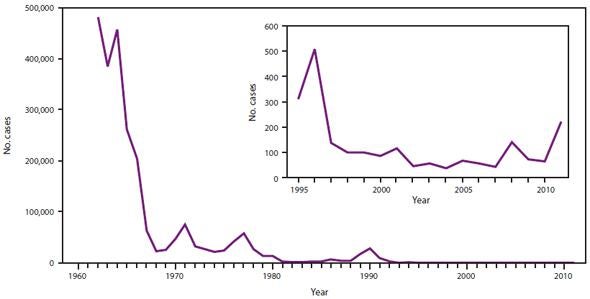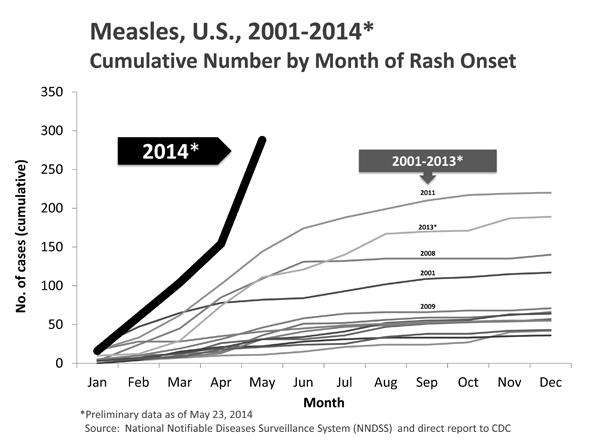So far this year, 288 cases of measles in the United States have been reported by the Centers for Disease Control and Prevention.
Two hundred eighty-eight. And mind you, that’s only through the first five months of the year (to May 23). This number is already higher than the total cases reported for any year going back to 1997 (and that includes last year, when the cases were triple their usual average). There haven’t been this many cases by this time of the year since 1994. Twenty years ago.
Why the sudden spike? Unvaccinated people. Specifically, unvaccinated American travelers who go overseas, catch the disease (where vaccination rates may be even lower than ours), and bring it back to the United States. A stunning 97 percent of the current cases are due to people visiting other countries and carrying the highly contagious disease back with them.
Unvaccinated travelers have caused many outbreaks in the states over the past few years. Of course, if vaccination rates here were where they are supposed to be, these numbers would be far smaller. Instead, unvaccinated travelers cause outbreak after outbreak because they bring it back to their largely unvaccinated community.

Graph by Huong Q. McLean et al.
The most cases so far have been in an Amish community in Ohio. In general, Amish people vaccinate at a lower rate than the rest of the population. This is due to many reasons (though of course, religious belief is one) but the end result is the same: potential victims. In the Ohio outbreak, it was a missionary trip to the Philippines—where there’s currently a measles epidemic—that started this and shows just why vaccination is so important.
Measles was considered eliminated domestically in the U.S. in the year 2000; that means there were no remaining reservoirs of it here. As the CDC site says,
The United States was able to eliminate measles because it has a highly effective vaccination program and a strong public health system for detecting and responding to measles cases and outbreaks.
However, it still exists out in the world, where it can use a host as its own passport. And because not enough people vaccinate here we get outbreaks. The reasons some people don’t vaccinate are varied; sometimes it’s due to religion, sometimes via simple inertia, sometimes (though rarely) for actual health reasons.
And of course, there are the anti-vaxxers, who are still vocal, still getting media attention, and still very, very wrong.
Measles is a dangerous disease; the symptoms are unpleasant, but they’re nothing compared with the potential complications, which include pneumonia, ear infections, diarrhea, encephalitis, and even death. It affects children more strongly than adults.
Please, please, go to see a board-certified doctor and make sure your vaccinations are up to date. Mine are, and so are my family’s. You don’t want to become a statistic, and I’m sure you don’t want to infect someone else and have them become one, either.
